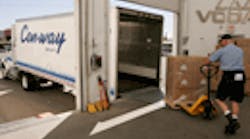Faced with an ever-growing shortage of truck drivers, fleets are engaging in a variety of efforts to find and keep willing hands to hold a big rig’s steering wheel for a career. Not only are fleets starting up their own driver training schools, but recruiting efforts in have intensified, even within their own companies.
LTL carrier Saia, for one, is stepping up efforts to comb the ranks of its dockworkers to find employees with the right safety mindset and work ethic to help pilot its fleet of 2,475 city and 1,820 linehaul tractor-trailers.
“We’re looking to significantly expand our internal recruiting efforts in 2012,” explained Marty Ready, Saia’s vp-human resources, in an interview with Fleet Owner. “There’s a great demand for drivers in this industry, but the advantage we see in recruiting from within is that we know the work ethic and mindset of those employees already.”
Ready said that workers displaying the right safe operating skills when using yard tractors to “hustle” trailers between dock locations are encouraged to attend local truck driving schools, and upon successfully obtaining their commercial drivers license (CDL) get “finishing training” from Saia’s veteran drivers.
Fellow LTL carrier Con-way Freight is following a similar format in terms of recruiting from its dockworker ranks to be trucks drivers – though it’s going several steps further by establishing its own national network of driver training schools.
Launched in March 2010, Con-way’s 12-week driver-training program now operates in 84 cities across the U.S. and is provided at no cost to candidates. Students earn income as dockworkers while learning their new profession. The company recently graduated its 500th driver from the program late last year.
A bigger paycheck is one of the big incentives to move from dockworker to driver at Saia, Ready pointed out. “Our city drivers get a higher wage than our dockworkers and as those city drivers get experience, they are promoted into linehaul,” he added.
Not only are graduates from Saia’s “dock to driver” program some of the most loyal workers at the company – meaning they rarely leave to drive for other carriers – they also tend to be the safest group of new drivers, Ready reported.
“That’s because they are people who are already instilled with our safety beliefs, who know and follow our policy and procedures from their experience on the dock,” he explained. “They handle the customer’s freight like it was theirs – because they know that’s where their paycheck comes from.”
Carriers are also supporting state government initiatives to match the unemployed with job openings, especially for military veterans.
TL carrier Schneider National is strongly backing Wisconsin Gov. Scott Walker’s new “Wisconsin Working” plan, rolled out early this month. The plan in part calls for doubling the number of job fairs in that state this year, including 14 for military veterans alone, while increasing efforts to match people on unemployment insurance with jobs employers have to fill.
“These are exactly the kind of initiatives our company needs to fill many of our open roles, especially roles for professional truck drivers,” noted Chris Lofgren, Schneider’s president and CEO, who noted that carrier plans to hire 500 military members across the U.S. in 2012.
Saia’s Ready also stressed that his company’s “dock to driver” effort aims to correct a longer-term issue faced by the trucking industry as well: the “graying” of the truck driver workforce.
“The average age for our city and linehaul drivers was 45 and 49, respectively, last year – but the average age for the ‘new’ recruits for those positions in 2011 was 41 and 45, respectively,” he noted. “We just don’t see that 25 year old coming through the door to be a truck driver anymore. That’s why we’re trying to ‘grow our own’ for other areas within our company.”



